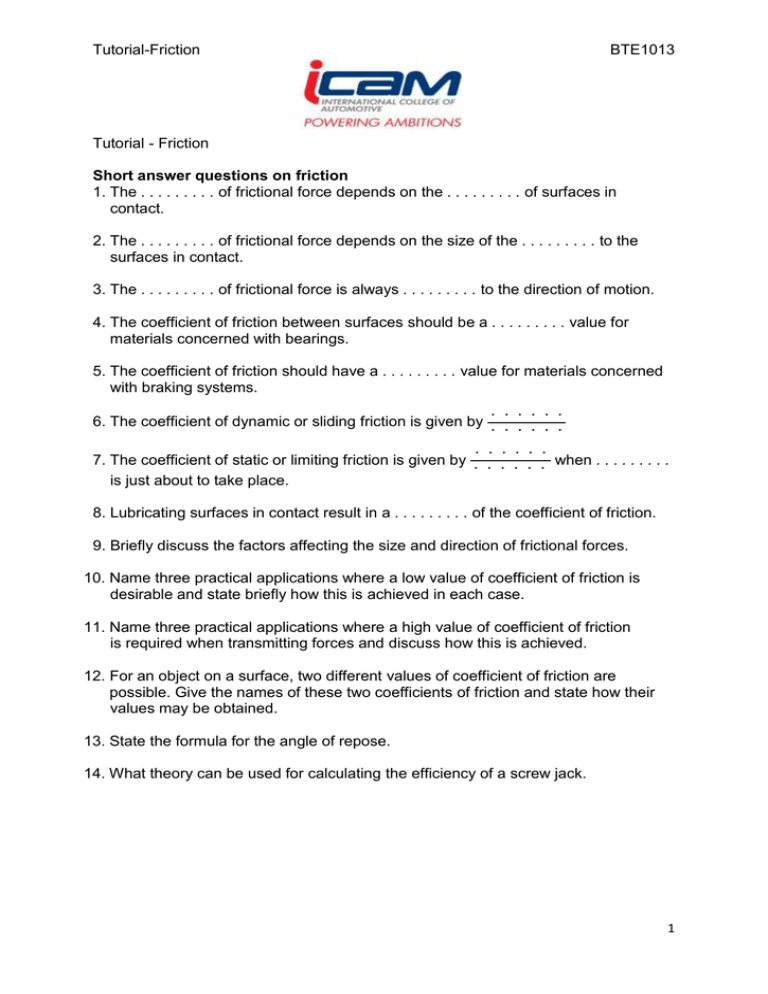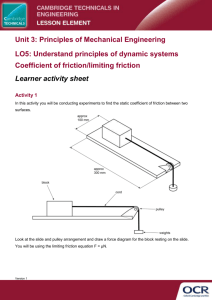Tutorial Friction
advertisement

Tutorial-Friction BTE1013 Tutorial - Friction Short answer questions on friction 1. The . . . . . . . . . of frictional force depends on the . . . . . . . . . of surfaces in contact. 2. The . . . . . . . . . of frictional force depends on the size of the . . . . . . . . . to the surfaces in contact. 3. The . . . . . . . . . of frictional force is always . . . . . . . . . to the direction of motion. 4. The coefficient of friction between surfaces should be a . . . . . . . . . value for materials concerned with bearings. 5. The coefficient of friction should have a . . . . . . . . . value for materials concerned with braking systems. ・・・・・・ 6. The coefficient of dynamic or sliding friction is given by ・ ・ ・ ・ ・ ・ ・・・・・・ 7. The coefficient of static or limiting friction is given by ・ ・ ・ ・ ・ ・ when . . . . . . . . . is just about to take place. 8. Lubricating surfaces in contact result in a . . . . . . . . . of the coefficient of friction. 9. Briefly discuss the factors affecting the size and direction of frictional forces. 10. Name three practical applications where a low value of coefficient of friction is desirable and state briefly how this is achieved in each case. 11. Name three practical applications where a high value of coefficient of friction is required when transmitting forces and discuss how this is achieved. 12. For an object on a surface, two different values of coefficient of friction are possible. Give the names of these two coefficients of friction and state how their values may be obtained. 13. State the formula for the angle of repose. 14. What theory can be used for calculating the efficiency of a screw jack. 1 Tutorial-Friction BTE1013 Exercise Multi-choice questions on friction 1. A block of metal requires a frictional force F to keep it moving with constant velocity across a surface. If the coefficient of friction is μ, then the normal force N is given by: (a)μ/F (b) μF (c)F/μ (d) F 2. The unit of the linear coefficient of friction is: (a) newtons (b) radians (c) dimensionless (d) newtons/metre Questions 3 to 7 refer to the statements given below. Select the statement required from each group given. (a) The coefficient of friction depends on the type of surfaces in contact. (b) The coefficient of friction depends on the force acting at right angles to the surfaces in contact. (c) The coefficient of friction depends on the area of the surfaces in contact. (d) Frictional force acts in the opposite direction to the direction of motion. (e) Frictional force acts in the direction of motion. (f) A low value of coefficient of friction is required between the belt and the wheel in a belt drive system. (g) A low value of coefficient of friction is required for the materials of a bearing. (h) The dynamic coefficient of friction is given by (normal force)/(frictional force) at constant speed. (i) The coefficient of static friction is given by (applied force) ÷ (frictional force) as sliding is just about to start. (j) Lubrication results in a reduction in the coefficient of friction. 3. Which statement is false from (a), (b), (f) and (i)? 4. Which statement is false from (b), (e), (g) and (j)? 2 Tutorial-Friction BTE1013 5. Which statement is true from (c), (f), (h) and (i)? 6. Which statement is false from (b), (c), (e) and (j)? 7. Which statement is false from (a), (d), (g) and (h)? 8. The normal force between two surfaces is 100 N and the dynamic coefficient of friction is 0.4. The force required to maintain a constant speed of sliding is: (a) 100.4 N (b) 40 N (c) 99.6 N (d) 250 N 9. The normal force between two surfaces is 50 N and the force required to maintain a constant speed of sliding is 25 N. The dynamic coefficient of friction is: (a) 25 (b) 2 (c) 75 (d) 0.5 10. The maximum force, which can be applied to an object without sliding occurring, is 60 N, and the static coefficient of friction is 0.3. The normal force between the two surfaces is: (a) 200 N (b) 18 N (c) 60.3 N (d) 59.7 N 11. The formula for the angle of repose is: (a) F = μN (b) tan θ = μ (c) μ = F/N (d) tan θ = sin θ/cos θ 3



